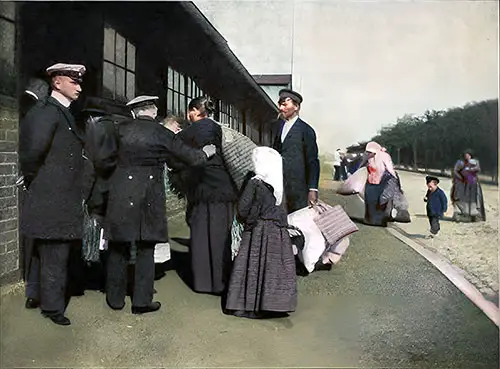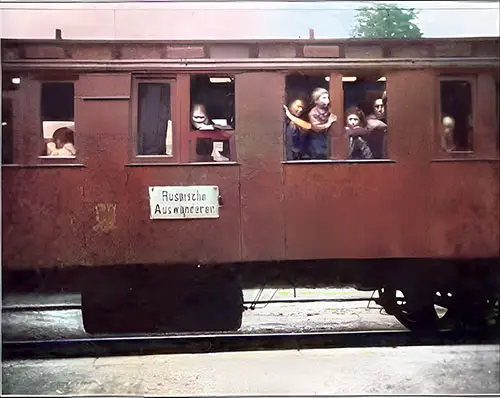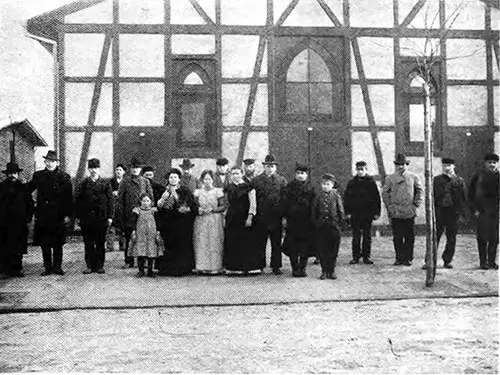Emigration to North America

White Star Line Memo Notifying Agents that Steerage is Filled to Capacity dated 13 April 1892. GGA Image ID # 1d99992e3a
To fully understand immigration, we must look at the causes and conditions that caused people to emigrate from their homelands to North America (Canada and the United States). Historical articles from the latter half of the nineteenth and early twentieth centuries help provide insight into our immigration issues.

Emigration from Liverpool - 1850
For teachers, students, genealogists, family historians, and immigration researchers, this detailed account of emigration from Liverpool in 1850 offers an unparalleled glimpse into the journey of millions of emigrants leaving Europe for North America. Liverpool was the largest departure port for Irish, English, and European emigrants, making this article an essential historical resource for those tracing family migration routes or studying 19th-century immigration policies, travel conditions, and passenger experiences.

Emigration from Liverpool in 1859
The Emigration from Liverpool in 1859 article offers a detailed and data-rich exploration of one of the busiest departure points for emigrants seeking new opportunities across the globe. This resource is invaluable for teachers, students, genealogists, family historians, and immigration researchers seeking to understand migration patterns, government policies, and the broader context of 19th-century emigration.

Provisional Emigration Law of Norway - Provisorist Anordning 1867
The Provisional Emigration Law of Norway (1867) is one of the most important legal documents in Norwegian emigration history. This article provides a crucial perspective for teachers, students, genealogists, family historians, and researchers studying the mass movement of Norwegians to North America and beyond. With nearly 900,000 Norwegians emigrating between 1820 and 1930, this law played a foundational role in shaping emigration policies, regulating agents, and documenting those who left their homeland.

Who Should Emigrate to Canada and the United States (1883)
For teachers, students, genealogists, family historians, and immigration researchers, Who Should Emigrate to Canada and the United States? offers an invaluable perspective on the realities of emigration in the late 19th century. This article challenges the common perception of America as an "Eldorado," instead presenting a balanced and realistic look at the opportunities and hardships awaiting immigrants.

For teachers, students, genealogists, and family historians, this article sheds light on a critical but often overlooked aspect of immigration history—women's emigration in the late 19th century. It highlights the efforts of women’s emigration societies that provided financial and logistical support to single women seeking opportunities in British colonies. Understanding the emigration of women—their challenges, motivations, and support networks—offers invaluable insight for researchers tracing family histories or studying gender roles in migration history.

Emigration of Women from Great Britain in 1888
For teachers, students, genealogists, family historians, and researchers, this detailed article on the emigration of women from Great Britain in 1888 is an invaluable resource for understanding the social, economic, and gendered aspects of migration history. It highlights how women’s migration was not just a necessity but a transformative opportunity, offering better economic prospects for individuals and helping to balance gender disparities in colonial societies.

The Journey to America: The Grueling Paths of Immigration in 1902
Published in Scribner’s Magazine in 1902, "In The Paths of Immigration to America" provides a gripping, first-hand account of the grueling journey faced by Russian and Eastern European immigrants traveling to America. This historical piece delves into the challenges of immigration, health inspections, restrictive policies, and the harrowing reality of being deemed "unfit" to enter the United States.
For teachers, students, genealogists, historians, and immigration scholars, this article serves as a valuable primary source, offering a rare, detailed perspective on the immigration process at the turn of the 20th century. The vivid descriptions, powerful illustrations, and emphasis on bureaucratic obstacles make this an essential read for anyone studying migration patterns, Ellis Island procedures, and the human cost of immigration policies.

Emigration from Rotterdam to the United States circa 1903
For teachers, students, genealogists, family historians, and immigration researchers, this article on Emigration from Rotterdam to the United States (circa 1903) provides a detailed and rare look into the pre-departure inspection and medical screening process for emigrants traveling on the Holland-America Line. It offers firsthand insights into the journey of thousands of European emigrants who passed through Rotterdam, making it an essential resource for anyone studying transatlantic migration.

Emigration to the United States via Hamburg, Germany circa 1903
For teachers, students, genealogists, family historians, and immigration researchers, this article on Emigration to the United States via Hamburg (1903) provides a meticulously detailed account of the rigorous processes that European emigrants underwent before embarking on their journey to America. It is a must-read for those studying immigration policies, public health measures, and the experiences of emigrants from Russia, Austria-Hungary, and other European nations.

For teachers, students, genealogists, and family historians, immigration is often viewed as a one-way journey to America. However, Return Immigration (1903) uncovers a lesser-known but equally vital aspect of migration: the cyclical movement of immigrants between their homeland and the United States. This article is an invaluable resource that provides a nuanced perspective on immigration patterns, revealing that many immigrants, particularly Italians and Eastern Europeans, did not always remain in the U.S. permanently but instead traveled back and forth in response to economic opportunities, weather conditions, and family obligations.

Immigration to the US: Considering The Causes Of Emigration - 1904
For teachers, students, genealogists, family historians, and immigration researchers, this in-depth article on Considering the Causes of Emigration provides a comprehensive analysis of the driving forces behind immigration to the United States and how they shaped immigration policies and legislation over time. It is an essential read for anyone looking to understand why millions left their homelands and the broader historical factors that influenced global migration patterns.

Italy's Attitude Toward Her Emigrants - 1905
For teachers, students, genealogists, and family historians, a thorough understanding of immigration must include the push factors—the reasons people left their homelands—and the policies that shaped their journey. Italy’s Attitude Toward Her Emigrants (1905) is a critical resource that provides an in-depth look at the official stance of the Italian government on emigration, the challenges Italian emigrants faced, and their integration into American society.

How Immigration Is Stimulated -1906
For teachers, students, genealogists, family historians, and immigration researchers, this insightful article offers a compelling exploration of how immigration to the United States was artificially stimulated in the early 20th century. Through a detailed analysis of steamship companies, labor recruiters, and transatlantic migration trends, it exposes the forces that fueled one of the most significant waves of immigration in American history.

The Human Side of Immigration - Italian Emigration to America - 1906
For teachers, students, genealogists, family historians, and immigration researchers, this article is a must-read exploration of Italian immigration to the United States, offering rich insights into the economic, social, and cultural factors that shaped the experience of Italian immigrants. It provides an in-depth analysis of why Italians left their homeland, their struggles and successes in America, and how they influenced both countries.

Emigrants leaving Europe by way of Rotterdam, 1908
For teachers, students, genealogists, family historians, and researchers, this article is a crucial resource for understanding European emigration through Rotterdam—one of the most important departure ports for immigrants traveling to North America. The article provides detailed statistics, historical insights, and first-hand accounts of the migration process, making it an essential read for those studying immigration patterns, family heritage, and transatlantic voyages.

Emigration from the German Ports of Hamburg and Bremen (1911)
For teachers, students, genealogists, family historians, and researchers, this in-depth historical account of emigration from the German ports of Hamburg and Bremen provides essential insights into transatlantic migration patterns, steamship competition, and the economic forces driving German and East European emigration to America. The article offers a comprehensive view of how major shipping lines shaped the migration experience and made these ports central gateways to the New World.

For teachers, students, genealogists, and family historians, this article provides a rare and detailed account of the vital role immigrant hotels played in the European emigration process. These establishments were not simply lodging houses but key transitional spaces where emigrants awaited their journeys to America, undergoing medical inspections, quarantine procedures, and logistical preparations. Understanding these hotels sheds light on ancestral migration patterns, immigration policies, and the social conditions of emigrants before their Atlantic crossing.

For teachers, students, genealogists, family historians, and researchers, the Emigration Image Library is an extraordinary visual archive that brings the history of immigration to life. This collection of rare photographs, newspaper clippings, illustrations, and historical documents offers firsthand perspectives on the emigrant experience from departure to arrival.
Recap and Summary of the Emigration to North America
The Emigration to North America section provides an invaluable collection of historical articles that shed light on the journey, experiences, and challenges faced by emigrants as they left their homelands for North America. This section is a must-read for teachers, students, genealogists, family historians, and immigration researchers seeking to understand the causes, conditions, and consequences of transatlantic migration.
By delving into these historical accounts, readers can gain firsthand insights into the legal, economic, and social factors influencing emigration, as well as the pre-departure experiences, policies, and hardships that shaped immigrant journeys. Each article in this section provides a unique lens into a different aspect of the emigration process, from departure points like Liverpool and Rotterdam to immigration control stations in Hamburg and medical inspections at Castle Garden.
Highlighted Articles – The Best Choices for Insightful Study
While all articles in this section are valuable, some stand out as essential resources due to their historical significance, depth of coverage, and firsthand accounts of emigration experiences. Below are the top recommended articles, along with what makes them the best choice:
1. In the Paths of Immigration to America (1902)
🔹 Why It’s a Must-Read:
- This in-depth account provides a step-by-step journey of emigrants, particularly from Russia, as they navigate bureaucratic barriers, medical inspections, and hardships before even setting foot in America.
- Key Highlights: Control stations, health inspections, steerage conditions, and the emotional impact on emigrants.
- Best For: Teachers, students, genealogists, and researchers studying transatlantic emigration routes and experiences.
2. Return Immigration (1903)
🔹 Why It’s a Must-Read:
- While most studies focus on immigration into America, this article highlights the lesser-known phenomenon of return migration, where a significant percentage of immigrants went back to Europe, often after accumulating wealth.
- Key Highlights: Economic cycles affecting migration, seasonal migration patterns among Italians, and the financial success of returnees.
- Best For: Genealogists and historians interested in tracking cyclical migration trends and economic migration patterns.
3. Italy’s Attitude Toward Her Emigrants (1905)
🔹 Why It’s a Must-Read:
- This article presents an in-depth analysis of Italian emigration policies, addressing myths and misconceptions about Italy’s role in migration to America.
- Key Highlights: How Italy regulated emigration, debunking the idea of Italian “colonies” in the U.S., and policies that shaped migration patterns.
- Best For: Family historians and students studying Italian immigration and government policies.
4. Who Should Emigrate to Canada and the United States? (1883)
🔹 Why It’s a Must-Read:
- This article challenges romanticized views of immigration, offering practical advice and warnings about the harsh realities of life in North America.
- Key Highlights: Who thrived in America and Canada vs. who struggled, economic opportunities vs. hardships, and what emigrants needed to succeed.
- Best For: Educators, students, and researchers examining immigrant expectations vs. realities.
5. Emigration to the United States via Hamburg (1903)
🔹 Why It’s a Must-Read:
- Offers an unparalleled look at the strict control measures emigrants underwent before being allowed to embark for America.
- Key Highlights: Medical inspections, public health concerns, and the impact of Hamburg as a major emigrant departure hub.
- Best For: Those researching public health policies, Ellis Island procedures, and pre-departure immigrant experiences.
6. Emigration for Ladies (1883) & Emigration of Women from Great Britain (1888)
🔹 Why They’re Must-Reads:
- These articles offer a rare look at women’s emigration, a topic often overlooked in broader immigration studies.
- Key Highlights: Support networks for women, challenges of female emigration, and women’s role in shaping immigrant communities.
- Best For: Those researching gender and migration history or tracing female ancestors.
7. Emigration from Liverpool (1850 & 1859)
🔹 Why They’re Must-Reads:
- Liverpool was one of the most important departure ports for emigrants heading to North America.
- Key Highlights: Firsthand descriptions of the embarkation process, passenger conditions, and the role of British emigration policies.
- Best For: Researchers interested in British emigration and early transatlantic migration.
8. Emigrant Hotels in Europe
🔹 Why It’s a Must-Read:
- Provides an often-overlooked aspect of emigration—the transitional period between leaving home and boarding a steamship.
- Key Highlights: Lodging conditions, pre-departure health checks, and immigrant accommodations in major European ports.
- Best For: Those studying pre-departure emigration policies and immigrant experiences before crossing the Atlantic.
Final Thoughts: Why This Section is Essential for Understanding Immigration History
The Emigration to North America Index offers an unparalleled window into the past, capturing firsthand accounts, policy changes, and the realities of transatlantic migration. These articles bridge the gap between emigration and immigration, helping readers understand why people left, how they traveled, and what awaited them in the New World.
- For educators, this section provides primary-source historical material that can be used to illustrate classroom lessons.
- For genealogists and family historians, it offers essential background information that can help in tracing ancestral migration routes.
- For students and researchers, it serves as a comprehensive guide to transatlantic migration patterns and policies.
By exploring these articles, readers gain a deeper, more personal understanding of the emigration experience, making this section an indispensable resource for anyone interested in immigration history.
